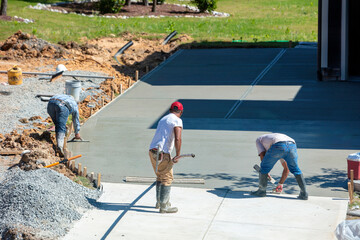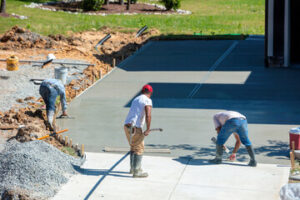The First Steps in Concrete Repair

Concrete Repair Colorado Springs regularly repair and update concrete surfaces such as driveways, walkways, floors, slabs, bridge decks and foundations. These procedures may include surface repair, crack sealants or epoxy or urethane injections.
 No matter the type of repair—whether structural, reforming a residential concrete step, or stopping water flow in an active crack—there are several crucial considerations that will affect whether your concrete repair will last.
No matter the type of repair—whether structural, reforming a residential concrete step, or stopping water flow in an active crack—there are several crucial considerations that will affect whether your concrete repair will last.
The first step in concrete repair is determining what type and extent of damage you have. Some repairs only involve filling in cracks, while others require the replacement of concrete.
The next step is to clean the concrete surface. It is imperative that the concrete surface be free of dirt and debris in order for the new patch or concrete to cure properly. You can use a brush, broom, or power washer to clean the surface of the concrete. A blower is also recommended as it will allow you to get to those hard-to-reach spots where the concrete has been damaged.
Once the surface has been cleaned, it must be saturated with water to ensure that it is fully damp. A dry concrete surface will not bond well to the existing concrete. If the concrete is in severe condition, you may need to perform more aggressive preparation techniques, such as vacuum blasting, dry or wet grinding, needle scaling, scarifying, scabbling, and/or chemical etching.
When preparing the concrete for a concrete replacement, it is important to follow a strict procedure. It is essential that the replacement concrete make an integral bond with the existing concrete, and a low w/c ratio along with a high percentage of coarse aggregate is needed to minimize shrinkage cracking.
It is always best to have a professional engineer or supplier design the concrete mix for your project. However, contractors can play a large role in the selection of the proper mix design for their job. The proper mix design will depend on the location, placement method, and owner’s needs.
Lastly, you should inspect the existing concrete for any areas that need to be repaired or replaced. This will include removing protrusions that are sticking out more than 1/16″. You should also inspect the surface of the concrete for delaminations by hitting it with a hammer. Delaminated areas will send back a dull sound, unlike the hard ring of sound concrete.
Materials
Concrete is a very durable material and is used for many applications in our everyday lives. However, over time, concrete can deteriorate and become damaged. Fortunately, repair of concrete is fairly simple with the help of special repairing products designed specifically for this purpose. The first step in repairing concrete is to find the right materials to use. These should be non-shrink, easy to apply and compatible with the parent material. It is also important to choose a durable material that will not accelerate the existing damage.
Some of the common repair materials are Portland cement mortar and grout, latex modified Portland cement mortar or concrete, quick-setting non-shrink concrete, and polymer concrete. Each has its own unique properties and advantages. Choosing the appropriate repair materials for a specific structure will depend on a number of factors, including the structure’s service conditions and the cost.
Once the proper materials have been selected, they should be applied to the surface of the damaged concrete. The surface should be free of loose debris and clean of contaminants, such as oil, grease, dirt, or other chemicals. This can be accomplished by sandblasting or shotblasting the affected area. It is also a good idea to use a water or air pressure washer for larger or heavily soiled areas.
The most important factor in determining the success of a repair is the quality of the bond between the new material and the existing concrete. This is achieved through careful preparation of the repair area and the selection of suitable concrete repair materials.
A successful repair should allow the internal stresses in the concrete to be transferred across the repair plane. This will result in a higher stiffness and load capacity for the repaired section. This is particularly important in flexural members where the tensile strength of concrete is low. It is for this reason that steel reinforcement is often added to concrete structures.
Increasing the number of repairs made to concrete structures due to durability failure has a significant impact on the environment and society. It leads to depletion of natural resources and produces massive quantities of carbon dioxide emissions and inert waste. Therefore, engineers have a responsibility to design eco-efficient repair systems that achieve specified performance levels with minimum environmental damage.
Mixing
Concrete is one of mankind’s greatest inventions, a durable material that can be used to build and erect buildings and other structures. However, over time concrete can degrade. There are many reasons why this happens, including changes in the weather. Concrete expands when it warms and contracts when it cools, causing the concrete to crack. This can create voids that collect pebbles, sand and other debris. This debris can weaken the structural integrity of the concrete and ultimately cause it to fail.
Repairing and patching concrete can be a challenging task, but it can be made easier by using a fast-setting cement mix. Many of the newer repair materials are polymer-based and have special properties that allow them to set up quickly. They can be applied to overhead and vertical surfaces, fill form voids and cracks, and treat honeycombing and other concrete defects.
The best repair concrete for structural applications will have similar properties to the parent concrete that was originally cast. For this reason, it is important that the concrete mix design of the batched repair concrete matches the original. If a proprietary bagged mix is being used, the Engineer should be consulted to determine if it can be approved for use in the particular application.
Prior to placing the repair concrete, the substrate must be thoroughly cleaned and prepared. The surface must be free of oil, grease, dirt and other contaminants that could interfere with the bonding of the new concrete to the existing substrate. A non-destructive evaluation should also be performed to locate the source of the problem. This can be accomplished with a variety of tools, including radar and infrared thermography.
Once the concrete is mixed, it should be placed in the repair area as soon as possible. If a conventional concrete pour is being used, it should be placed to a maximum depth of 3 m (10 ft). A vibratory screed or straightedge can be used to finish the repair and match the surface profile of the surrounding pavement.
As a final step, consider skim-coating the repaired surface with Sakrete Top ‘N Bond to enhance the appearance of the finished product. Once the concrete is cured, it will be inspected visually and sounded with firm hammer blows to ensure that it has reached an acceptable compressive strength.
Application
Concrete repair is used to address conditions that deteriorate the binding materials of concrete structures over time due to damage or environmental exposure. These conditions include surface scaling, cracks, physical impacts and deterioration of steel reinforcement. Before the application of concrete repair materials it is essential that the cause of deterioration or failure be identified and addressed. For example, if the failure is caused by chloride penetration through the concrete to the steel reinforcement then corrosion remedial measures must be implemented.
The deteriorated concrete is then repaired with appropriate materials to prevent further damage or failure. Typical repairs involve a combination of methods such as epoxy injection, routing and sealing, grouting, stitching, drilling and plugging and gravity filling of concrete cracks.
Prior to any concrete repair material being applied the surface of the concrete should be cleaned thoroughly to remove any dirt, debris or other contaminants that may affect the bonding of the repair material with the existing concrete. This can be accomplished by sandblasting, shot blasting or using any other method that is acceptable to the specification for the site. It is also a good practice to remove corrosion products from the concrete surface that are caused by reinforcing steel corrosion, prior to applying any repair materials.
Once the surface has been cleaned it is important that the structural integrity of the area being repaired be assessed. This will determine the type and size of the repair material required. The tensile strength of the concrete is also an important factor in selecting a repair material. This is particularly important for concrete bridge decks that will be subjected to heavy traffic loads and the effects of thermal stresses from changing temperatures.
Whether the concrete is being repaired with an unmodified Portland cement mortar or grout, a latex modified Portland cement mortar or grout or a quick setting nonshrink mortar or polymer concrete, a proper mix design must be used. The water content of the concrete is also an important factor to consider, especially if it will be exposed to freezing and thawing conditions.
